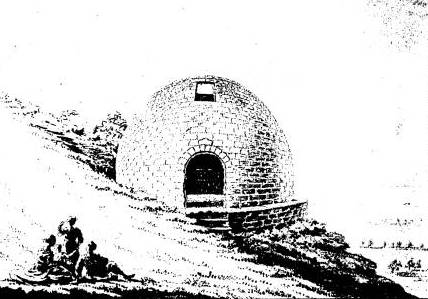Until 1743 the building known as Arthur’s O’on stood on rising ground above the north bank of the River Carron not far from the Carron ironworks. The story of this unique building runs like a thread through the many centuries of its existence from its construction during the Roman occupation, through the dark ages with the dubious links to the legends of King Arthur, to the time of its wanton destruction by Sir Michael Bruce.
Arthur’s O’on or Oven, as it was known, was shaped like a beehive or igloo and stood over twenty feet high with a similar base diameter. The four foot thick walls of dressed freestone narrowed towards the top which was open when detailed architectural drawings were prepared in 1726. Described then as “The Roman Sacellum of Mars Signifier, vulgarly called Arthur’s Oon” it was thought to be some kind of temple or shrine – a brass finger from a long lost statue found lodged inside the building seemed to confirm this view. From its position out in the open, well in front of the wall, some have argued that it was a triumphal monument set up to further remind the Caledonians and other tribes of their defeat and subjugation to the might of Rome. How it came to acquire the Arthurian association is unclear, but by the sixteenth century it was recognised by scholars as a Roman monument of considerable importance. This recognition did not preserve it from the Laird of Stenhouse who had it demolished to provide a cheap supply of dressed stones for a new weir.
Though it is gone it is far from forgotten. Every year or so a new theory, as unlikely as its predecessor, seeks to place the O’on in a scheme linking various sites in Scotland with the dark age King Arthur and his famous knights. But these fanciful ideas vanish just as quickly as they appear only to return once again in a year or so. A much more interesting development came in the late 1980s when an American researcher Robert Mitchell claimed that the stones of the O’on were not scattered beneath the Carron waters at all but lay under a dismantled blast furnace where they were deposited when the river changed its course. He thus held up the possibility of recovery and reconstruction in the future, but so far there has been no confirmation of the find and no response to the proposal. Indeed the whole notion of the Carron having changed course at this point has been dismissed by other researchers.
The site of Arthur’s O’on is now a housing estate, and no sign or mark tells a passer-by, or even the people who live there, of the former glory that lies beneath their feet. A sad finale indeed!
Ian Scott (2005)

